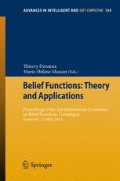Abstract
In many Artificial Intelligence applications, causality is an important issue. Interventions are external manipulations that alter the natural behavior of the system. They have been used as tools to distinguish causal relations from spurious correlations. This paper proposes a model allowing the detection of causal relationships under the belief function framework resulting from acting on some events. Facilitation and justification in the presence of interventions, concepts complementary to the concept of causality, are also discussed in this paper.
Access this chapter
Tax calculation will be finalised at checkout
Purchases are for personal use only
Preview
Unable to display preview. Download preview PDF.
References
Benferhat, S.: Interventions and belief change in possibilistic graphical models. Artif. Intell. 174(2), 177–189 (2010)
Benferhat, S., Bonnefon, J.-F., Chassy, P., Da Silva Neves, R., Dubois, D., Dupin de Saint-Cyr, F., Kayser, D., Nouioua, F., Nouioua-Boutouhami, S., Prade, H., Smaoui, S.: A Comparative Study of Six Formal Models of Causal Ascription. In: Greco, S., Lukasiewicz, T. (eds.) SUM 2008. LNCS (LNAI), vol. 5291, pp. 47–62. Springer, Heidelberg (2008)
Benferhat, S., Smaoui, S.: Possibilistic causal networks for handling interventions: A new propagation algorithm. In: AAAI, pp. 373–378. AAAI Press (2007)
Benferhat, S., Smaoui, S.: Quantitative Possibilistic Networks: Handling Interventions and Ascribing Causality. In: Gelbukh, A., Morales, E.F. (eds.) MICAI 2008. LNCS (LNAI), vol. 5317, pp. 720–731. Springer, Heidelberg (2008)
Benferhat, S., Smaoui, S.: Inferring interventions in product-based possibilistic causal networks. Fuzzy Sets and Systems 169(1), 26–50 (2011)
Bonnefon, J., Da Silva Neves, R., Dubois, D., Prade, H.: Background default knowledge and causality ascriptions. In: ECAI, pp. 11–15 (2006)
Bonnefon, J.F., Da Silva Neves, R., Dubois, D., Prade, H.: Predicting causality ascriptions from background knowledge: model and experimental validation. Int. J. Approx. Reasoning 48(3), 752–765 (2008)
Boukhris, I., Benferhat, S., Elouedi, Z.: A belief function model for ascribing causality. In: EPIA, pp. 342–356 (2011)
Boukhris, I., Elouedi, Z., Benferhat, S.: Modeling interventions using belief causal networks. In: FLAIRS, pp. 602–607 (2011)
Goldszmidt, M., Pearl, J.: Rank-based systems: A simple approach to belief revision, belief update, and reasoning about evidence and actions. In: KR, pp. 661–672 (1992)
Halpern, J., Pearl, J.: Causes and explanations: A structurel model approach. In: UAI, pp. 194–202 (2001)
Morin, B., Mé, L., Debar, H., Ducassé, M.: A logic-based model to support alert correlation in intrusion detection. Information Fusion 10(4), 285–299 (2009)
Pearl, J.: Causality: Models, Reasonning and Inference. Cambridge University Press (2000)
Shafer, G.: A mathematical theory of evidence. Princeton University Press (1976)
Shafer, G.: The Art of Causal Conjecture. The MIT Press (1997)
Smets, P.: The combination of evidence in the transferable belief model. IEEE Pattern Analysis and Machine Intelligence 12(5), 447–458 (1990)
Smets, P.: About updating. In: UAI, pp. 378–385 (1991)
Smets, P.: The transferable belief model for quantified belief representation, vol. 1, pp. 267–301. Kluwer Academic Publisher (1998)
Spohn, W.: Ordinal conditional functions: a dynamic theory of epistemic states causation in decision. In: Belief Changes and Statistics, pp. 105–134 (1988)
Wakker, P.: Dempster belief functions are based on the principle of complete ignorance. International Journal of Uncertainty, Fuzziness and Knowledge-Based Systems 8(3), 271–284 (2000)
Author information
Authors and Affiliations
Corresponding author
Editor information
Editors and Affiliations
Rights and permissions
Copyright information
© 2012 Springer-Verlag Berlin Heidelberg
About this paper
Cite this paper
Boukhris, I., Benferhat, S., Elouedi, Z. (2012). Ascribing Causality from Interventional Belief Function Knowledge. In: Denoeux, T., Masson, MH. (eds) Belief Functions: Theory and Applications. Advances in Intelligent and Soft Computing, vol 164. Springer, Berlin, Heidelberg. https://doi.org/10.1007/978-3-642-29461-7_27
Download citation
DOI: https://doi.org/10.1007/978-3-642-29461-7_27
Publisher Name: Springer, Berlin, Heidelberg
Print ISBN: 978-3-642-29460-0
Online ISBN: 978-3-642-29461-7
eBook Packages: EngineeringEngineering (R0)

